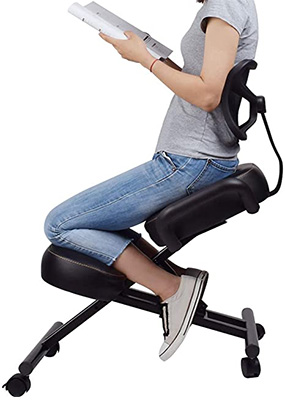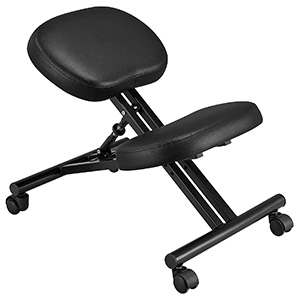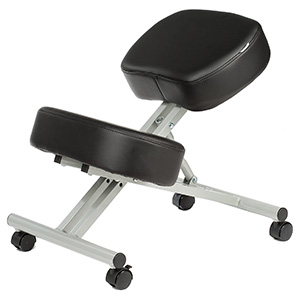Do you suffer from chronic back pain? Is it your sense that your current office chair may be contributing to the problem?
If you answered yes to either of those questions and you’ve been considering other office seating options for either home or work, you’re going to be glad you found this page. In the sections that follow, we’ll explore the full range of kneeling chair benefits, so you can get a good sense of whether or not an ergonomic kneeling chair is a good fit for you.
If your interest is piqued, read on, and let’s take a closer look.
Ergonomic Kneeling Chair Benefits—Initial Considerations
First and foremost, we should say that if you’re looking for a kneeling chair or stool that can serve as a 1:1 replacement for an office chair and you’re hoping that you can find something to spend all day sitting (kneeling) in, don’t get your hopes up.


While there are a number of really good kneeling stools and chairs on the market today, this is not the type of seating you’d want to use if you plan to sit on it for 8+ hours a day.
In fact, our recommendation would be to spend no more than 6 hours a day in even the best kneeling chairs on the market, and closer to 4 if you can get away with it.
If you’re only in your current office chair 4-6 hours a day, then yes, in that specific instance, you can use a kneeling chair as a 1:1 replacement for your current office chair. But more than that, you’ll probably want one of each—a “regular” office chair and a kneeling chair—so you can get the benefits of both types of seating.

The primary reason is that most kneeling stools don’t come with back support and the ones that do tend to be pricey and offer either basic or no lumbar support.
That sees you confronting a two-edged sword. On the one hand, one of the main benefits of an ergonomic kneeling chair is the fact that it enforces good posture. The downside, however, is that it enforces that posture rather harshly, and this type of seating can be rather exhausting to use for extended periods.
Normally, this would be the section where we talk about upholstery being a major consideration because—at least in the world of office chairs—if you get one with leather or PU upholstery, the more time you spend in it, the hotter and less comfortable you’re going to be.


Here, that’s much less of an issue, both because our recommendation right out the gate is to not spend too much time sitting on the kneeling chair in the first place and also because not nearly as much surface area of your body will wind up being in contact with the upholstery anyway, so it’s just less of an issue all around.
The main consideration, then, is a budgetary one. Will your budget support the idea of investing in an office chair with good lumbar and other ergonomic supports, plus a kneeling chair you can spend part of each day on?
If the answer to that question is yes, then you’re well-positioned to reap the benefits of having what amounts to the best of both worlds.
Kneeling Office Chair Benefits—What Are They And How Good Are They
We hinted at the biggest one in the last section, but here, we’ll go into more detail. One of the hands-down biggest kneeling chair benefits is the fact that this type of seating enforces correct posture. That’s not to say that you couldn’t find a way to sit “incorrectly” on a kneeling chair, but you’d have to go out of your way to do it, and it definitely wouldn’t be comfortable.

First, let’s take a closer look at the posture angle.
When you’re sitting in a regular office chair, you’ve got a 90-degree angle between your spine and where your legs bend at your waist.
In a kneeling chair, that angle is set to about 110 degrees, which doesn’t sound like a huge difference, but in reality, it makes a very big difference because it places significantly less pressure on the discs of your spine. Other kneeling desk chair benefits include:
Basically, everything about the kneeling chair’s design was meant to help reduce pain, so if you’re a chronic pain sufferer, investing in a kneeling chair will almost certainly help.
On the other hand, sitting in any position for too long is bad for you, and that, combined with the fact that using a kneeling chair can be a somewhat exhausting experience, only underscores the importance of having both a conventional office chair and a kneeling chair.
If you’ve got both, you can “switch off” at some point during the day, giving your core and back muscles a chance to rest from the unexpected workout they’ve been getting and giving your back a break from the limited—if not complete lack of—support.
In addition to that, spending too long in a kneeling chair can cause pain in your shins due to the increased pressure there. And since most kneeling chairs don’t have casters (a few do!), if you have to move around your office and you’re accustomed to doing so by simply rolling your chair around, you’re going to have to learn some new office habits.

That’s when you’ll discover that getting into and out of a kneeling chair tends to be harder than a conventional office chair. Obviously, it’s not a monumentally difficult task, but it’s something to bear in mind.
The good news is that if you’re sold on the various kneeling chair health benefits, they tend to be lightly constructed, which makes them easy to move. So when you decide you’ve had enough for one day, it’s a simple matter to pick it up and get it out of the way, then settle into your office chair for the remainder of your day.
Kneeling Posture Chair Benefits—Conclusion
There is a whole raft of kneeling stool benefits, and this type of seating is well worth considering, but there are a couple of important caveats.
The biggest one comes down to budgetary concerns. Kneeling chairs are best when used for no more than, say, half of a typical workday—so no more than four hours.
If you’re only spending about 4 hours a day in your current office chair, a 1:1 replacement becomes totally viable, but if you spend more time than that, then you’re going to want both (a kneeling chair and an office chair). And unfortunately, that’s not something that everyone will be able to afford to do.
The good news is that given the time constraints, upholstery concerns don’t really factor in because even if you get leather or PU-clad kneeling chair, you won’t be spending enough time in it each day for the lack of breathability in the upholstery to become an issue.
At the end of the day, though, if you can afford it, the simple truth is that investing in a kneeling chair and using it for 3-4 hours a day will provide you with a variety of kneeling chair benefits, and if you suffer from chronic pain, it will help to reduce that. That fact makes them well worth considering.
References and Resources:
- Ergonomically Designed Kneeling Chairs Are They Worth It? Comparison of Sagittal Lumbar Curvature in Two Different Seating Postures, National Center for Biotechnology Information.
- Effect of a Kneeling Chair on Lumbar Curvature in Patients With Low Back Pain and Healthy Controls: A Pilot Study, Research Gate.
- 10 Benefits of Good Posture, According to Experts, Byrdie.